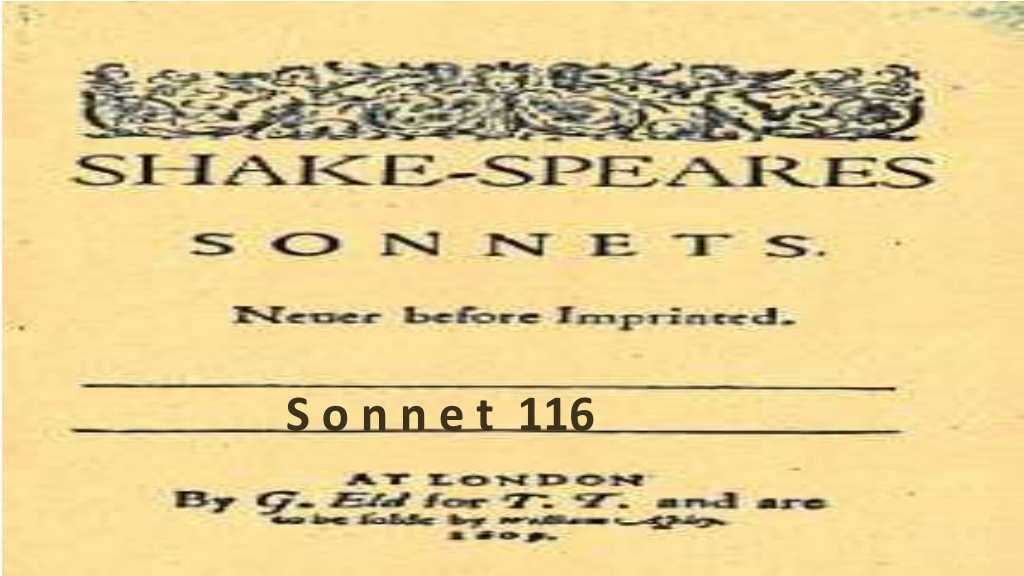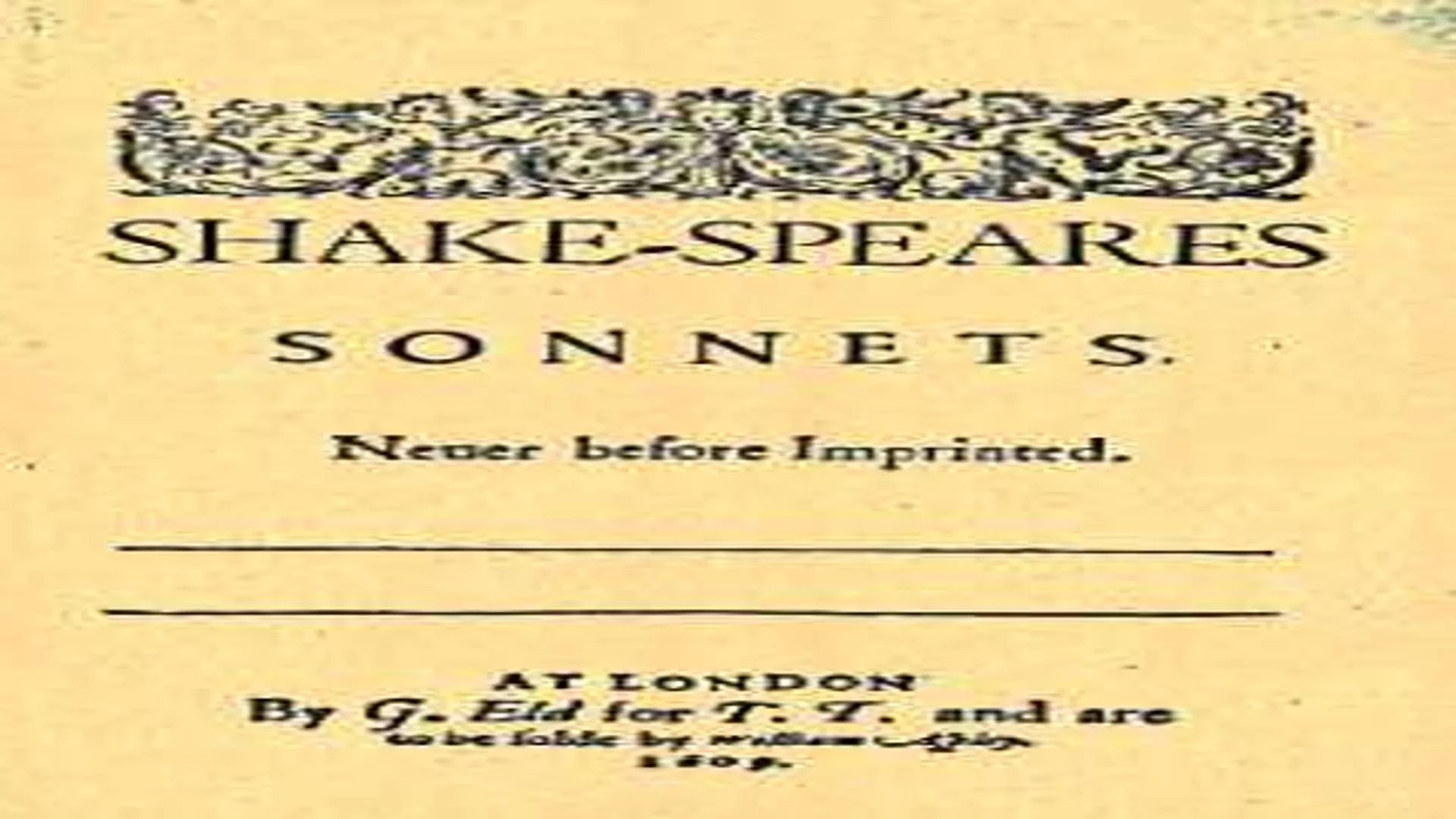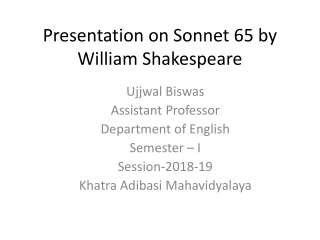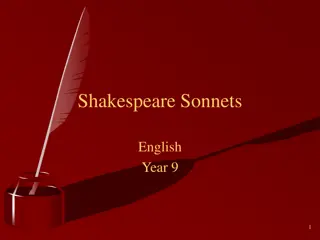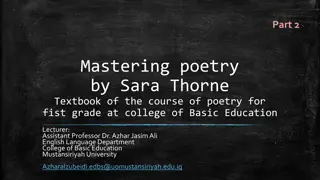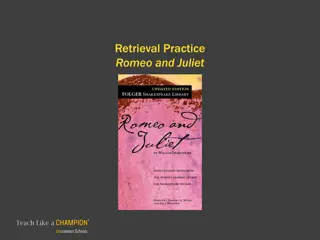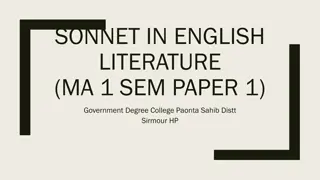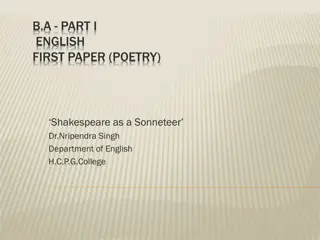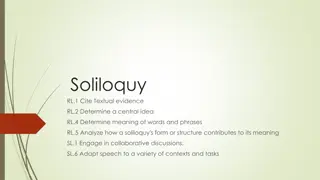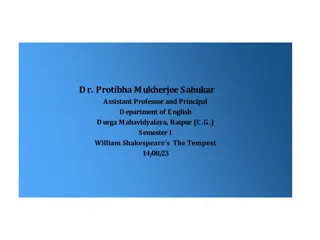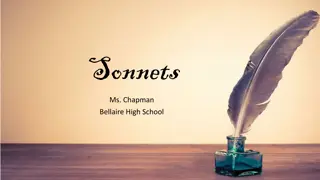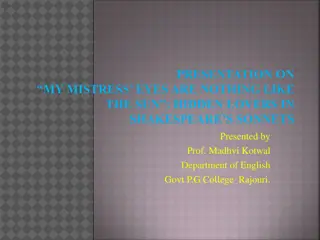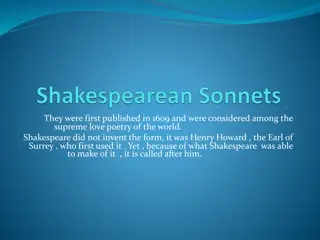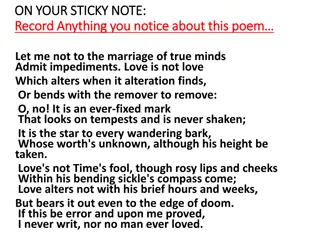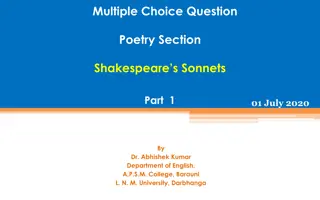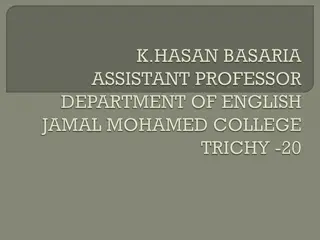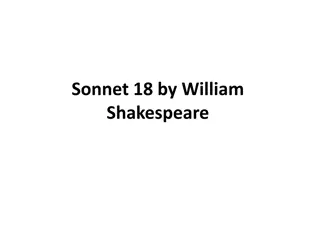Shakespearean Sonnets: Love, Structure, and Life of William Shakespeare
Explore the depth of Shakespearean sonnets, their structure, and themes of love intertwined with the life events of William Shakespeare. From unrequited love to poetic expressions, delve into the fascinating world of sonnets and the renowned playwright's journey.
Download Presentation

Please find below an Image/Link to download the presentation.
The content on the website is provided AS IS for your information and personal use only. It may not be sold, licensed, or shared on other websites without obtaining consent from the author. Download presentation by click this link. If you encounter any issues during the download, it is possible that the publisher has removed the file from their server.
E N D
Presentation Transcript
Reminder about sonnets Original Italian Sonnets are rhymed poems consisting of fourteen lines, the first eight making up the octet and the last six lines being the sestet. The Shakespearean Sonnet (which differs slightly from the Italian (or Petrarchian) Sonnet and the Spenserian Sonnet) end with a rhymed couplet and follows the rhyme scheme abab cdcd efef gg. Thus, the octet/sestet structure can be alternatively divided into three quatrains (sets of four lines) with alternating rhymes concluding in a rhymed couplet. Shakespearean Sonnets which consists of 154 sonnets falls into two groups: A. 1-126 : addressed to a beloved friend. B. 127-154: addressed to a malignant but fascinating Dark Lady , whom the poet loves in spite of himself.
Sonnets and love The story was of love -- love unrequited, love requited but unfulfilled (courtly love ?), love so fleetingly fulfilled as merely to make suffering keener, love thwarted by the beloved's absence, or aloofness, or prior possession by another. Impediment was as central to the sonnet as was love. Impediment produced the lyric voice. Without impediment, the lover would have no need to resort to poetry; he would have something better to do.
INTRODUCTION ~of Shakespeare 1564 :Shakespeare Born 1565-1581 :1567(?) Richard Burbage, the greatest tragedian of the age, who would eventually portray Hamlet, Lear, Othello and all Shakespeare's great parts born 1582 :Shakespeare Married 1583 :Birth of daughter Susanna The Queen's Company is formed in London 1585 :Birth of twins, Judith and Hamlet 1587(?)-1592 :Departure from Stratford Establishment in London as an actor/playwright (The Comedy of Errors, Titus Andronicus, The Taming of the Shrew, Henry VI, 1,2,3 Richard III ) 1593 :Preferment sought through aristocratic connections - dedicates Venus and Lucrece to Henry Wriothsley, Earl of Southampton - possibly the youth of the Sonnets (1593 Venus and Adonis, Begins writing the Sonnets, probably completed by c.1597 or earlier, Two Gentlemen of Verona,Love's Labour's Lost )
INTRODUCTION ~of Shakespeare 1594 :Founding member of the Lord Chamberlain's Men (1594 The Rape of Lucrece ) 1594-1596 :The Lyrical masterpieces Prosperity and recognition as the leading London playwright(Midsummer Night's Dream, Romeo and Juliet, Richard II Merchant of Venice ) 1597-1599 :Artistic Maturity Purchases New Place, Stratford with other significant investments (Henry IV,1,2, The Merry Wives of Windsor, As You Like It, Much Ado About Nothing, Henry V, Julius Caesar ) 1600-1608 :The Period of the Great Tragedies & Problem Plays (Twelfth Night,Hamlet,Troilus & Cressida, All's Well That Ends Well Measure for Measure, Othello, King Lear, Macbeth, Antony and Clepatra Coriolanus, Timon of Athens )
INTRODUCTION ~of Shakespeare 1609-1611 :Period of the Romances 1609 Publication of the Sonnets (Pericles Prince of Tyre Cymbeline The Winter's Tale The Tempest ) 1612-1616 :Shakespeare probably retires from London life to Stratford Works on collaborations with John Fletcher. March 1616 Shakespeare apparently ill revises his will April 23, 1616 Shakespeare dies and is buried at Holy trinity Church, Stratford (Henry VIII The Two Noble Kinsmen Cardenio )
PARAPHRASE PARAPHRASE Do not let me accept any difficulties in true love. Love (which changes when it finds an alteration in circumstances) is not love. Love (that bends to forces which intends to remove it) is not true love. Oh no! true love is a fixed mark (that sees storms but is never shaken by the storm); It [love] is the guiding star to every lost ship the value of the star can t be calculated, but its height can be used to find directions. Love is not at the mercy of Time (love cannot be fooled by time), though people s youth and beauty (rosy lips and cheeks) come within the influence of time (that our youth and beauty are harvest by [Time's] sickle) . Love does not alter with hours and weeks. But, rather, it endures until the end of the world. If I am proved wrong about these thoughts on love, then I recant all that I have written, and no man has ever [really] loved.
Analysis of Sonnet 116 Revision Material GCSE English Literature (AQA) Unseen Poetry
Analysis Let me not to the marriage of true minds Admit impediments; love is not love Which alters when it alteration finds, Or bends with the remover to remove. O no it is an ever-fixed mark, That looks on tempests and is never shaken; It is the star to every wand'ring bark, Whose worth's unknown, although his height be taken. Noun love can conquer all Metaphor of non physical (Courtly ?) love Person does not change. Repetition of words Love brings stability.(meta phor) Love is strong. Love is personified. Comparing love to a star metaphor. Refers to lost ship, offers clarity Sibilance. Refers to how love is priceless Internal rhyme.
Analysis Love's not Time's fool, though rosy lips and cheeks Within his bending sickle's compass come; Love alters not with his brief hours and weeks, But bears it out even to the edge of doom. If this be error and upon me proved, I never writ, nor no man ever loved. Immortality imagery of youth and then of decay, but love would not change and is more powerful than time Love is everlasting Personification. Love does not give up. Resilience. Juxtaposition to the idea of love. Promoting love negative connotations Rhyming Couplet. Has air of certainty and authority Hyperbole and criticism for those whom never loved and who do not believe in its power.
Structure 1. Love is constant and strong (The first quatrain) 2. Love will survive any crisis, love s actual worth cannot be known.( The second quatrain) 3. Love is stable throughout any changes. ( The third quatrain) 4. The poet stands firmly of his judgment.( The final couplet )
Metaphors (1) 1. ever-fixed mark: permanent and unshakeable, always there as a guide to the storm tossed mariner. 2. marriage of true minds: true means constant, faithful, unchanging, truthful and this suggests a union that is non-physical, Platonic and idealistic. The language draws us to think about the marriage service and that is a ceremony designed specifically to marry two people, not two abstract Platonic ideals which have decided to be wed. 3. his bending sickle: all life is fleeting, and human life is measured by the brief hours and weeks of experience. In comparison with theeternity of love, any unit of time is short. 4. compass: scope, the arc of the circle created by the sweep of the sickle. Referring to the previous lines, time, with his sickle, sweeps down the mortal lovers, the rosy lips and cheeks, as if they were blades of grass. 5. rosy lips and cheeks: all mortal beauty but especially between lovers. They are cut down by Time s sickle.
Metaphors (2) 6. Time s fool, bending sickle s compass, brief hours and weeks, the edge of doom: all of these words are related to time. Time is the most frequently repeated concept and image in the Sonnets. This is the pervasive Renaissance theme of mutability, and the poet presents various ways to defy Time. --- Time s fool: in terms of the fool employed in large establishments by the nobility, a favoured character whose writing and joking was much enjoyed. --- bending sickle: an agricultural implement consisting of a hook-shaped metal blade with a short handle fitted on a tang. In this sonnet, the bending sickle implies the Time is flying so fast in a way that is similar to cutting the grass with the bending sickle. But only difference is that: time is cutting away people s beauty and youth. 7. star: it lights in the high clear-dark sky. The star implies love can guide every lost ship and find the right direction, so they won t get lost or separate from love.
AOs AO1 well structured, uses appropriate terminology, understands concept of sonnet AO2 metaphor, personification, rhythm and rhyme (structure of Shakespearean sonnet), sibilance, nouns and adjectives etc AO3 Shakespearean sonnet, who is sonnet addressed to, other work poems by Shakespeare, idea of courtly/non-physical love, reference to (and echo of)Christian marriage ceremony in 1st line AO4 type of sonnet, is message of this sonnet typical ? Is this type of love possible found in other texts ? Ideas of Time contrast with To his Coy Mistress AO5 -Some say this sonnet was written to a beloved young man and others that it is not a typical sonnet as it is a conceptual consideration of love rather than a specific example of love.
